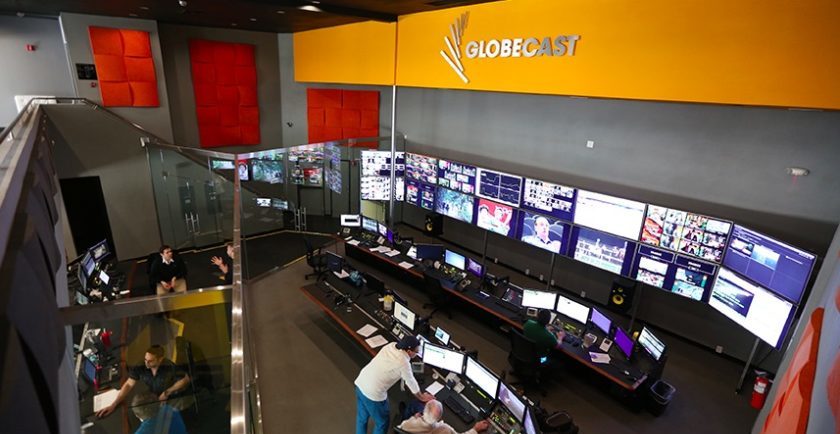
Globecast: Tackling Content Distribution on a Worldwide Basis
If there’s a media and entertainment company out there that truly lives up to its name, Globecast must be considered.
A fiber-optic network stretching beyond 57,000 miles, nearly 30 dedicated satellites, a dozen interconnected facilities across five continents, all combine to give the Culver City, Calif.-based company the ability to offer a broad selection of traditional and non-traditional services for broadcasters, including multiplatform delivery offerings like OTT, TV Everywhere and VOD.
Tim Jackson, SVP sales and marketing, the Americas for Globecast, chatted with the Media & Entertainment Services Alliance (MESA) about Globecast’s origins, its work on a unique direct-to-consumer UHD/HDR service, and how the company’s digital theatrical work could be of use to North American theater owners.
MESA: How did Globecast get off the ground? What was the impetus, and what was the thinking when the company got its start?
Jackson: The U.S. division of Globecast started as a separate privately held company way back in the mid-1980s. Our Culver City facility, which serves as the headquarters for Globecast America, got its start as a company called IDB Communications in the mid-1980s, and operated under the IDB umbrella until it merged with France Telecom to form Globecast in the mid-1990s.
Globecast is a fully owned subsidiary of Orange Business Services, which is the business-to-business (B2B) division of Orange, which is what France Telecom eventually evolved into. Orange serves millions of video, voice and data consumers throughout Europe, primarily in France, Globecast under OBS is a global provider of media services to the entertainment industry.
So, if we look at how that breaks down, Orange Business Services is mainly an IT provider, providing telco-based services: dial-tone, private-line services, internet connectivity, and private/public network services to business around the world. Globecast is a provider of contribution, distribution and media management services to broadcasters, programmers, service providers, and others within the entertainment industry ecosystem.
MESA: When researching your company, I kept seeing your CAAD service – Content Acquisition, Aggregation and Delivery — for premium channels and pay TV providers in general. Speak a little bit about this service. What makes it unique? What makes it a standout?
Jackson: One of the areas of focus for Globecast America a few years ago was a product called World TV, which was a direct-to-home (DTH) service that comprised ethnic channels from different markets around the world, brought into the U.S. so that people that have migrated here — or are here temporarily — can have access to local media from home. And this was a very wide-ranging platform.
What happened is that those channels obviously are very niche, and to provide something on a DTH platform became quite expensive, especially because at the time technologies were morphing more into online services and on-demand services.
So, what we did was refocus that World TV business into the CAAD business. We aggregate, acquire the rights to, and get distribution for, high-value foreign content channels with carriage in the U.S. We distribute across platforms like Verizon FiOS and other providers that tend to focus on providing these foreign language and international ethnic channel media options for viewers. It’s a big differentiator for MVPDs and other service providers. And that’s an area we’re looking to grow quite a bit, because we really see an opportunity there for more niche programming.
MESA: I also noticed your Cinema Delivery Solution. What are the challenges with supplying for that industry? We’re in an all-digital world now. How do you manage sending all these large files where they need to go and do it seamlessly? Speak a little about the challenges there.
 Jackson: Digital cinema is very much localized, like any cinema really, just because of the customization. And Windows is a very localized operation. So, the digital cinema work that we do at Globecast right now is limited to Europe. We haven’t had the opportunity yet to enter the U.S. market, but based on our expertise with what we’ve done for digital cinema in Europe, we would certainly like to have the opportunity.
Jackson: Digital cinema is very much localized, like any cinema really, just because of the customization. And Windows is a very localized operation. So, the digital cinema work that we do at Globecast right now is limited to Europe. We haven’t had the opportunity yet to enter the U.S. market, but based on our expertise with what we’ve done for digital cinema in Europe, we would certainly like to have the opportunity.
Digital cinema can be handled in several different ways. One is simply the continued distribution of hard drives via a physical medium, which effectively is the same way things have been done in the past with big reels of film. The other is the distribution of films either over high-speed data connections or by satellite. Satellite has been a pretty good way to go simply because of the large file sizes that films require, and because it’s a one-to-many distribution model. But content security is something to always be aware of with either distribution model.
There are very few companies that have this expertise in digital cinema distribution: it’s a very limited, yet much-needed product. We’re constantly looking for ways that we can expand what we have done quite well in Europe to different parts of the world.
MESA: On to VOD. Obviously, things have changed. We’re seeing new services pop up every day. What are some of the challenges (multi-screen support, 4K, HDR) you’re seeing in the VOD space nowadays?
Jackson: Along with DVR, VOD was the first, truly non-linear alternative viewing option, just turning on the TV and seeing what was available to you on the program guide. And, that really became the first means of viewing content where you didn’t have to be in front of the TV set at exactly the right time.
VOD means alternative deliveries beyond the purview of traditional MVPDs. There are skinny bundles being offered by a myriad of different providers, and it’s really a matter of figuring out how to reach the consumer, reach the viewers, and being able to be recognized as one of the key service providers.
The challenge for MVPDs in this space is avoiding tethering to specific set-top boxes. At Globecast we recognize that there are still many opportunities for traditional distribution over satellite, and over fiber, of linear channels. That’s where we offer most of our services and make most of our money.
We feel it’s going to continue to be a duel track of the traditional method of television operations and television delivery along with the new model of OTT — linear and non-linear — or real-time and VOD OTT services, so that we can evolve the business as consumer choice becomes more prevalent. It’s a challenge that everyone is facing, because when you look at the average revenue per user of traditional cable, satellite, telco, video subscription, it’s somewhere in the neighborhood of $80. And the average revenue per user of someone like Hulu and Netflix is down to about under $10. And some of these skinny bundles hover around $20 to $35.
So we’re seeing that consumers are faced with an awful lot of choice and often it means that they’re reducing their costs for that. And that makes the ability to be very efficient in how you operate and provide these services super critical. That’s where I think Globecast provides a great value to the marketplace by leveraging a lot of economies to scale and being able to do lots of services for different customers in a cost-effective manner.
MESA: In terms of use case examples, is there anybody that you’d like to highlight? Anybody that you’ve worked with that really got a lot out of what you guys offer?
Jackson: One of the things we’re really excited about is something that we showcased at NAB and will be showcasing again at IBC. And that’s a direct-to-consumer UHD/HDR service. One of the big challenges in reaching consumers with UHD and in particular HDR is the set-top box. Smart TVs all have the ability to download apps from an app store similar to how we currently use our phones and tablets. And if you look at TVs from folks like Samsung, LG and Sony, they all have app stores where you can offer a service that consumers can download directly to their TV. We partnered with Harmonic and Vive Lifestyle Networks at NAB to show this ability to provide compelling UHD/HDR content to consumers, without relying on the massive infrastructure upgrades that would be required by a MVPD.
It’s technologies like those that enable consumers to take advantage of the extremely high quality enabled by new televisions, rapid time-to-market services, that are incredibly compelling and exciting for us. This is something where, say, a customer had either a film or a series or just a little bit of compelling, interesting stuff that they wanted to show, it can be downloaded to our platform in Culver City and published across a CDN to these apps that reside on the televisions and can be made available to the consumers almost instantly.
And there’s a variety of ways that can be monetized, either on a pay-per-view basis, a subscription basis, or a purchasing-of-the-app basis. So really what it does is provide very quick access to compelling content easily, without having to burden the consumer with set-top boxes and other pieces of hardware that they don’t already have.
MESA: What’s next for you guys? What can we look forward to? Are there areas that Globecast isn’t into yet that you’d like to explore?
Jackson: What we’re looking forward to in the remainder 2017 and into 2018 is broadening our customer base with key media customers throughout the U.S. We feel that we offer very cost-effective services in all manner of the subsets of the media ecosystem, whether it’s traditional program origination to satellite delivery networks. Whether it’s disaster recovery services, providing a secondary facility to customers that own and operate their own primary facility. And also providing customers with ways to expand and launch additional services in a cost-effective manner without them having to invest directly in the assets and the labor in order to do that.
So, for us, we look at the business really as several different subsets. We talked about CAAD as a line of business that we want to expand by attracting more compelling ethnic content to our catalogue. The distribution business, which is providing a means of getting TV networks distributed to different providers around the country. And there’s media management services, which means being traditional in your program origination as well as any of the advanced mobile and other types of emerging platforms.
Offering back-up services is another, providing disaster-recovery services to media companies that need a secondary facility as protection in the event of loss of a facility, loss of resources, power outages, natural disasters, or what have you. That’s a key area of focus for us.
